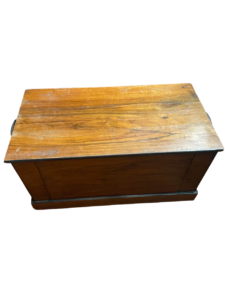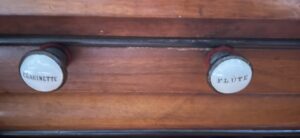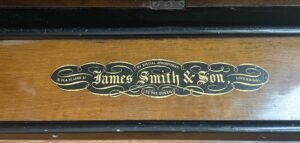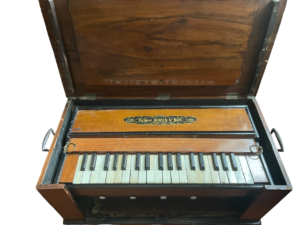Travelling Harmonium by James Smith & Son c. 1875
Description

| Date: | 1875 |
| Origin: | Liverpool |
| Serialnumber: | --- |
The Emergence of the Harmonium
The origins of the harmonium lie at the intersection of European organ traditions and Asian mouth-organs such as the Chinese sheng. In 1779, Christian Gottlieb Kratzenstein in Copenhagen designed the first free‑reed instrument, drawing direct inspiration from Chinese prototypes. By circa 1810, Germany witnessed the production of early keyboard instruments employing free reeds—namely the Aeoline (Eschenbach & Schlimbach) and the Physharmonika (Anton Haeckl)—which anticipated the harmonium’s structure and mechanics. A pivotal advancement came thereby in around 1833, with Gabriel Joseph Grenié’s orgue expressif in France, enabling dynamic tonal variation through air pressure modulation. The consummate form was realised by Alexandre‑François Debain, who patented the first instrument under the name harmonium in 1840/42. Equipped with pedal‑operated bellows and a wind reservoir, Debain established the technical benchmarks that would define harmonium construction throughout the nineteenth century.
Technical Variants: Pressure‑bellows versus Suction‑bellows Systems
Debain’s original conception was a pressure‑bellows instrument, whereby the air stored in a wind reservoir is released upon key depression. In the United States, from the 1860s onwards, James Cahart and subsequently Mason & Hamlin introduced the suction‑bellows harmonium, wherein air is drawn through under‑pressure. This design proved simpler, more economical, and better suited to mass production—and by around 1870 had come to dominate the world market.
The Harmonium’s Evolution in India
In the late nineteenth century, the harmonium was introduced to India by European missionaries and colonial officials. Encountering a rich indigenous musical tradition, the instrument was rapidly adapted to local contexts. A transformative innovation was made by Dwarkanath Ghose of Dwarkin & Sons in Calcutta in 1875: he replaced the European pedal‑bellows design with a hand‑pump, to accommodate the practice of performing while seated on the ground. Additionally, drone‑stops and a scale‑changer were incorporated to meet the exigencies of Indian music—such as the rendering of ragas and microtonal intervals.
By approximately 1915, India had become a principal centre of harmonium production—especially in Bengal and Gujarat. The so‑called Indian hand harmonium emerged as a standard instrument across devotional, classical, and popular musical spheres.
Integration and Controversies
During the twentieth century, the harmonium became central to ensemble accompaniment and solo expression throughout South and Southeast Asia—particularly in Ghazal, Qawwali, Bhajan, and Hindustani classical styles. Musicians such as Bhaiyya Ganpatrao integrated the instrument into the thumri repertoire of the Khayal tradition.
At the same time, the harmonium was embroiled in cultural controversy. In India’s nationalist movement, it was widely perceived as a symbol of Western hegemony. Rabindranath Tagore famously described it as “the bane of Indian music”. All India Radio banned its use in classical music broadcasts in 1940—a prohibition that was not fully lifted until 1971. Nonetheless, the Indian harmonium remained an enduring fixture of South Asian musical practice to this day.
Travelling Harmoniums in the Late Nineteenth Century
Concurrently with the harmonium’s adoption in India, a specialised variant—the travelling harmonium—emerged during the late nineteenth century. These instruments were compact, foldable, lightweight, and able to withstand challenging climatic conditions—making them ideal for missionary use in remote territories.
Christian mission societies introduced travelling harmoniums to numerous colonial regions, including India, China, and Japan. They were employed in liturgical accompaniment, in mission schools, at ecclesiastical stations, and in domestic worship—especially where full‑scale organs or pianos were impracticable.
- In China, from the 1890s, harmoniums were integrated into mission schools to teach Western hymnody and music theory.
- In Japan, during the Meiji era (1868 – 1912), harmoniums featured in Christian educational institutions. Notably, Yamaha later emerged as one of the first domestic producers of such reed‑organs.
- In India, travelling harmoniums delivered by missionaries quickly became adapted locally and absorbed into indigenous musical forms (as noted above).
These instruments were generally foldable into case‑form, with reduced keyboards and limited registers—features that rendered them practical for improvised congregational accompaniment, whether in a tent‑meeting or mission school setting. Moreover, they served an educational function: facilitating hymn‑singing, choir practices, and instruction in Western music notation. In this capacity, they exerted a significant influence upon local musical cultures—particularly in India, where the harmonium ultimately evolved into a culturally transformed, indigenous fixture.
The Travelling Harmonium by James Smith & Son
The specimen under discussion is a foldable travelling harmonium, crafted circa 1875 by James Smith & Son of Liverpool. Its case is fashioned from polished rosewood (palisander), and it is preserved within its original travel box, complete with brass handles on either side for practical carriage.

Harmoium James Smith and Son, Liverpool ca. 1875 (3) – Eric Feller Collection
The instrument features a keyboard overlaid with ivory and rosewood, spanning three octaves (C–C³). Beneath the keyboard lie five register levers, activating the registers Clarinette, Flute, Forte, Celeste, and one undecipherable label, each mounted with small ceramic plaques bearing inscriptions.

Harmoium James Smith and Son, Liverpool ca. 1875 (7) – Eric Feller Collection
In the open state, two cloth‑lined foot pedals emerge, housing the bellows mechanism. On the instrument’s upper surface appears the following signature:
“By Special Appointment
76, 74, & 72 Lord St. – James Smith & Son Liverpool
To The Queen.”

Harmoium James Smith and Son, Liverpool ca. 1875 (signature) – Eric Feller Collection
The timbre is notably compact, direct, and somewhat nasal in character. Though its resonating body is modest compared to that of larger cabinet harmoniums, it retains the quintessential tonal hue of free‑reed instruments. Articulation is immediate, with limited sustain.

Harmoium James Smith and Son, Liverpool ca. 1875 (5) – Eric Feller Collection
Registers such as Flute or Celeste produce softer, flute‑like tones, whereas Forte and Clarinette render brighter, more assertive colours. Although acoustically constrained by virtue of its compact size, the instrument nevertheless yields a surprisingly lively and tonally varied sound, subtly refined by the player’s manipulation of air pressure.
James Smith & Son (Music Sellers), Liverpool
The firm James Smith & Son (Music Sellers) Ltd., located at 72–76 Lord Street, Liverpool, is one of the most longstanding musical instrument retailers in northern England. Its development not only reflects the history of the music trade in the 19th and 20th centuries but also the profound transformations that the British musical landscape underwent due to industrialisation, colonial history, wartime impacts, and technological change.
1. Foundation and Rise (1825–1912)
Founded in 1825, James Smith & Son quickly established itself as a significant music shop on one of Liverpool’s central commercial streets. The location on Lord Street provided high visibility and accessibility – a decisive advantage in this booming port and industrial city. By the latter half of the 19th century, the company ranked among the leading suppliers of keyboard instruments, particularly pianos and grand pianos, as well as harmoniums and organs.
A renovation of the premises by the renowned architectural firm William Culshaw & Son in 1874/75 gave the shop a modern appearance. The display of musical instruments – notably over 24 concert grands – testified not only to economic strength but also to cultural ambition.1
2. The Wright Era and the Golden Age (1912–1939)
In 1912, the company was acquired by Ernest Sidney Wright, whose family ran it for several generations. Under his leadership, James Smith & Son became the largest sheet music retailer in the Merseyside region and a supplier to numerous cultural institutions.
Of particular note was the company’s role in equipping transatlantic luxury liners of the Cunard Line with high-quality grand pianos – a task requiring both craftsmanship excellence and logistical expertise. The premises also served as a venue for concerts by prominent pianists and as an examination site for music grades. The store thus became a cultural centre far beyond mere commerce.2
3. Destruction during World War II and Loss of Archives
A decisive event was the destruction of the premises during the 1942 air raids. As a result of the German bombings of Liverpool (The Blitz), the shop and all company archives were lost to fire. Consequently, essential documents relating to the company’s early history were irretrievably destroyed – a loss which significantly complicates historical reconstruction today.3
4. Structural Change and End of Instrument Trading (1945–1974)
After the war, both economic and cultural circumstances changed fundamentally. With the advent of new media, altered consumption habits, and a declining interest in classical home music, the company’s focus shifted.
The sale of the last grand piano in 1974 symbolised the end of active musical instrument retail at James Smith & Son. In this context, the longstanding piano tuning contract with the Liverpool Philharmonic Orchestra was also terminated – another indicator of the company’s evolving role.4
5. Present Day: From Musical Instrument Retailer to Consumer Electronics Store
Today, the company continues under the original name James Smith & Son (Music Sellers) Ltd., but has entirely specialised in the sale of television and audio equipment. It operates branches in the Southport area and the surrounding Liverpool region. The tradition is thus maintained, albeit under changed conditions.
Despite this transformation, the company’s history remains a significant testimony to the role of music retail in British urban and cultural history. It exemplifies how closely trade history, colonialism, urban infrastructure, instrument manufacturing, and musical culture are interwoven.
References
- Bygone Liverpool, “Lord Molyneux’s House and the Early Development of Lord Street, Liverpool,” https://bygoneliverpool.wordpress.com/2021/02/14/lord-molyneuxs-house-and-the-early-development-of-lord-street-liverpool/.
- Facebook post on the history of James Smith & Son (Music Sellers), https://www.facebook.com/photo.php?fbid=741153039382821&id=127403904091074.
- British Record Shop Archive, “James Smith & Son, Liverpool,” https://britishrecordshoparchive.org/shops/james-smith–son/.
© Eric Feller – Early Keyboard Collection – June 2025
| Length: | 26 cm |
| Width: | 56 cm |
| Height: | 16 cm |
| Circumference: | 3 octaves (c – c3) |
| Mechanics: | pressure wind harmonium |
| Pedals: | Registers: 5 (Clarinette, Flute, Forte, Celeste, [undecipherable label]) |
| Signature: |
“By Special Appointment 76, 74, & 72 Lord St. – James Smith & Son Liverpool To The Queen.” |

